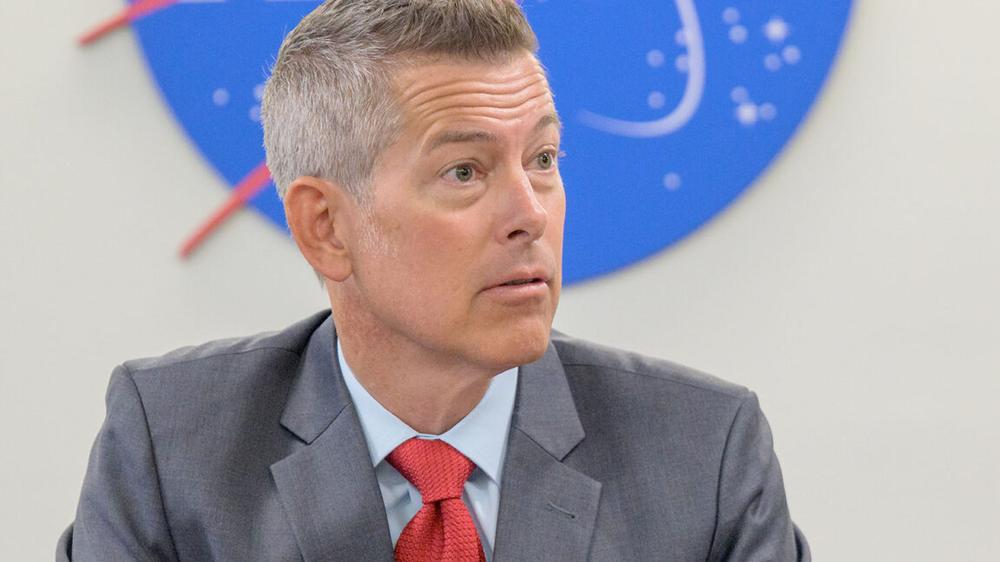NASA's interim administrator, Sean Duffy, said Thursday he has heard the recent talk about how some people are starting to believe that China will land humans on the Moon before NASA can return there with the Artemis Program.
"We had testimony that said NASA will not beat China to the Moon," Duffy remarked during an all-hands meeting with NASA employees. "That was shade thrown on all of NASA. I heard it, and I gotta tell you what, maybe I am competitive, I was angry about it. I can tell you what, I'll be damned if that is the story that we write. We are going to beat the Chinese to the Moon."
Duffy's remarks followed a Congressional hearing on Wednesday during which former Congressman Jim Bridenstine, who served as NASA administrator during President Trump's first term, said China had pulled ahead of NASA and the United States in the second space race.
"Unless something changes, it is highly unlikely the United States will beat China’s projected timeline to the Moon’s surface," said Bridenstine, who led the creation of the Artemis Program in 2019. China has said multiple times that it intends to land taikonuats on the Moon before the year 2030.
A lot of TV appearances
Duffy's remarks were characteristic of his tenure since his appointment two months ago by Trump to serve as interim administrator of the space agency. He has made frequent appearances on Fox News and offered generally upbeat views of NASA's position in its competition with China for supremacy in space. And on Friday, in a slickly produced video, he said, "I'm committed to getting us back to the Moon before President Trump leaves office."
Sources have said Duffy, already a cabinet member as the secretary of transportation, is also angling to remove the "interim" from his NASA administrator title. Like Bridenstine, he has a capable political background and politics that align with the Trump administration. He is an excellent public speaker and knows the value of speaking to the president through Fox News. To date, however, he has shown limited recognition of the reality of the current competition with China.
It is not just Bridenstine who is concerned about NASA losing to China in space. Respected China analyst Dean Cheng recently told Ars, "At the rate things are going, sadly, it seems quite likely that the Chinese will land on the Moon before NASA can return to the Moon."
NASA is on track to conduct a lunar flyby mission in early 2026 (the agency is currently working toward a February launch date for Artemis II), and the administration will undoubtedly seek to promote this as evidence of success. It's not, though.
The key elements of this mission, including the Orion spacecraft (begun in 2005) and Space Launch System rocket (begun in 2011), have been in development for decades and cost more than $50 billion. At one time, Artemis II was slated to fly in 2021. Nothing should be taken away from the bravery of the astronauts flying the mission, but it is not even as ambitious as Apollo 8 in 1968, which flew into lunar orbit rather than going out to the Moon and directly back.
To actually land on the Moon with Artemis III, NASA will need SpaceX to deliver a human-rated Starship vehicle, Axiom to complete spacesuits, and its own engineers to piece together and sign off on a complex plan that will be fraught with risk. The current, nominal target for such a mission is 2027, but no reasonable observer believes that is possible. For Duffy to make good on his promise of "getting us back to the Moon" before the president leaves office would require a landing by January 2029 or for Trump to violate the 22nd Amendment.
Change the safety culture?
One way in which NASA might speed up a lunar landing is by cutting through some of the agency's safety culture, which has multiple layers. For some people within the agency, the multiple safety reviews for NASA missions are a necessary safeguard after the space shuttle Challenger and Columbia tragedies. For others, they are an overgrown bureaucracy that hampers progress. During his meeting with employees on Thursday, Duffy expressed the latter viewpoint.
"We are safety-driven, and we should be safety-driven," Duffy said during the all-hands meeting. "But sometimes we can let safety be the enemy of making progress. We have to be able to take some leaps. We have to jump forward in our innovation and drive this mission. And there is always a balance to that. But we can’t side on the side of doing nothing because we are too afraid of taking risk. We have to push forward."
In truth, NASA will probably need to relax its safety culture and also see SpaceX, with the ambitious Starship vehicle, deliver a number of miracles in the next few years for US astronauts to land on the Moon before 2030. Given SpaceX's history of achievement, this should not be ruled out. But the company still has a long way to go.
To date, Duffy has talked a big game about the space race. The key question: Is this all high-minded political talk from people who will be gone when Mandarin becomes the lingua franca on the Moon?
A little more than five years ago, Vice President Mike Pence gave a rousing speech in Alabama, setting a goal of landing humans on the Moon by 2024 and laying the political groundwork for the Artemis Program and all that has followed. He said NASA had to change to be successful. "If our current contractors can't meet this objective, then we'll find ones that will," Pence said at the time.
The year is 2025, and the contractors are still the same.

 Star Wars: Where Were the Knights of Ren in the Sequel Trilogy? Now We Finally Know
Star Wars: Where Were the Knights of Ren in the Sequel Trilogy? Now We Finally Know